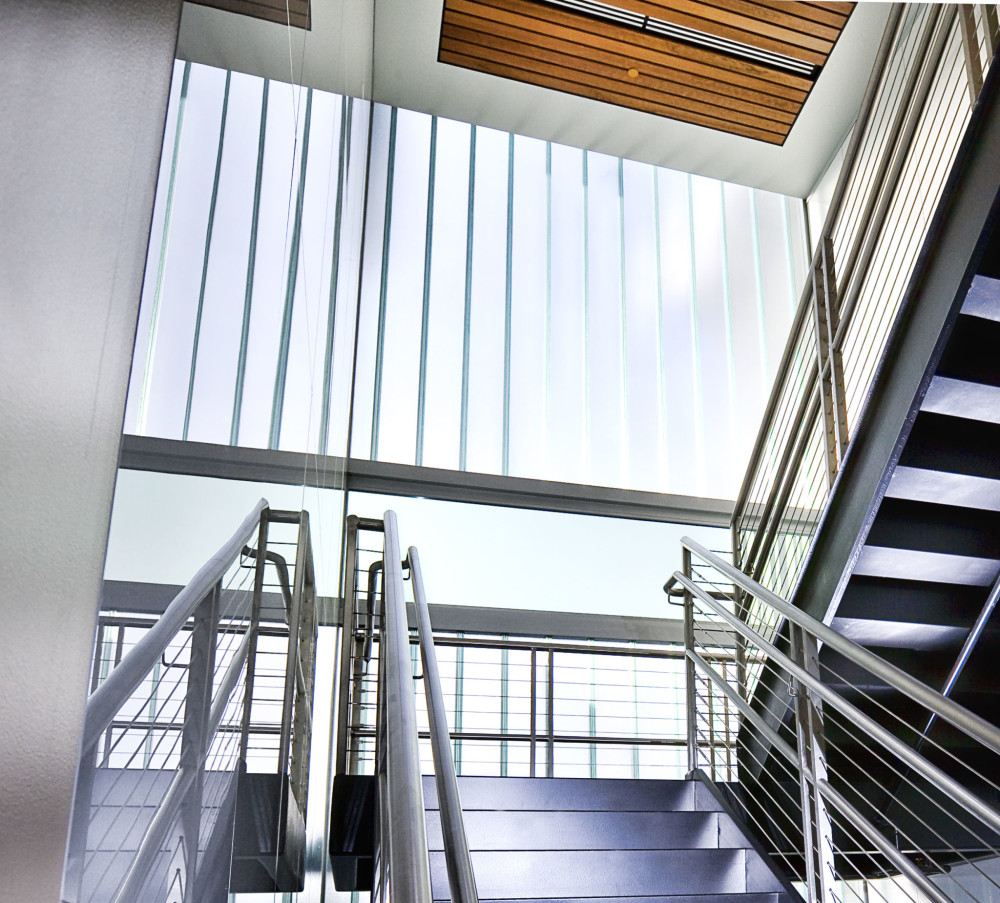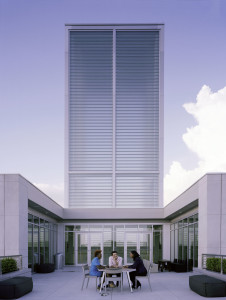
Photos courtesy TGP
Specifying high-performance assemblies
by Jeff Razwick
As shown in Parts One and Two of this article series, design professionals can use channel glass’ slender, versatile shape to transfer daylight into interiors with style, create object architecture, or add ‘movement’ to a building. For those new to the material, a common question is whether these design benefits extend to buildings with stringent hurricane, sound, and thermal insulation requirements.
Thanks to the material’s distinctive shape and composition, the answer can be ‘yes,’ but it depends on the product. Manufacturers can apply coatings, polycarbonate laminates, films, and other surface treatments to channel glass, creating a glazed system that provides a superior level of performance without sacrificing important design goals. As these high-performance products differ from the standard channel glass options discussed in the first two parts of this series, the following article will provide an overview of today’s advanced channel glass systems, starting with hurricane-rated channel glass.
Hurricane-rated channel glass
For design professionals interested in specifying channel glass in coastal regions, there are two types of hurricane-rated systems available to protect building occupants from high winds and windborne debris when a storm strikes—large and small missile impact-resistant channel glass.
Large-missile impact-resistant channel glass
Large-missile impact-resistant channel glass systems provide the highest level of hurricane protection available in North America. The advanced systems incorporate channel glass with a polycarbonate laminate bonded to its inside surface to meet Miami-Dade County and state of Florida requirements—the current hurricane-code benchmarks. They are tested and approved to the following standards:
- Miami-Dade County and Florida state’s requirements for the large-missile impact test (per Florida Building Code [FBC] testing application standard (TAS) 201-94; cyclic wind pressure loading per FBC TAS 203-94; and FBC TAS 202-94, which is specific to the air and water portions of the testing);
- small-missile impact test (ASTM 1996-06, Standard Specification for Performance of Exterior Windows, Curtain Walls, Doors, and Storm Shutters Impacted by Windborne Debris in Hurricanes); and
- cyclic loading (ASTM 1886-06, Standard Test Method for Performance of Exterior Windows, Curtain Walls, Doors, and Storm Shutters Impacted by Missile(s) and Exposed to Cyclic Pressure Differentials) at 100 percent of the design pressure (DP), as defined in ASTM 1996-06.
Design professionals can specify large-missile impact-resistant channel glass for hurricane- or impact-rated applications. In either situation, the glass channels are approved for heights up to a maximum of 3 m (10 ft), and can be installed in vertical configurations only. No wind anchors are needed at this height. Where desirable to create extended expanses of glazing, the framing and narrow glass channels can be stacked over floor slabs. The channel glass segments can also be raked, making it possible for the panels to change elevation gradually across their width to create visual interest in a vertical plane.
Since large-missile impact-resistant channel glass systems are tested for large and small missile resistance and cyclic loading, they can protect against high winds and windborne debris without supplemental protective devices like films or shutters. This helps preserve the sleek, contemporary lines desired by many architects.

Small-missile impact-resistant channel glass
Small missile impact-resistant channel glass systems use heat strengthened and filmed cast-glass channels and an extruded perimeter frame that have been tested and approved in accordance with the small missile impact test. Since the system does not pass the large-missile test, it is limited to a minimum of 9 m (30 ft) or higher above ground level. When installed at the appropriate height, the cast-glass channels provide great design freedom in storm-prone regions.
For example, the cast-glass channels can be installed in vertical and horizontal orientations, and can extend up to 3.7 m (148 in.) high in vertical applications and 4.1 m (162 in.) wide in horizontal applications. The vertically glazed channels can be raked or stepped, and can incorporate stacked joints to create dramatic glazed façades that protect against storm damage.
This flexibility proved advantageous when Sottile & Sottile; Lord, Aech & Sargent; and Dawson Architects were designing a glass tower to sit atop the Savannah College of Art Design (SCAD) Museum of Art’s 19th-centruy brick remains. By specifying small-missile impact-resistant channel glass in a horizontal, dual-glazed configuration, they were able to create a 26.2 m (86-ft) tall tower that punctuates the Savannah skyline by day and is backlit at night.
While small-missile impact-resistant channel glass opens up room for design creativity in hurricane regions, one important caveat is it cannot be installed in curved and serpentine orientations, as can standard channel glass systems.




